

|  |
Alfred Hermann Fried [1864-1921] |
Alfred Hermann Fried [1864-1921] was an Austrian Jewish pacifist, publicist & journalist. He co-founded the German peace movement & (with Tobias Asser [1838-1913]) received the Nobel Prize for Peace in 1911.
Click here for Baroness von Suttner.
Right click image to enlarge. / Zum Vergrößern auf das Bild klicken.
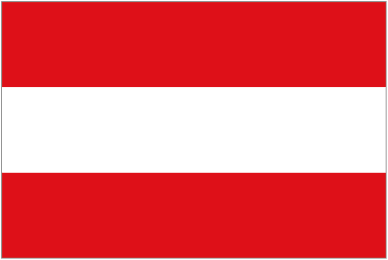 November 11, 1864 - Birth in Vienna (Austria-Hungary).
November 11, 1864 - Birth in Vienna (Austria-Hungary).
 

 | B
O
O
K |
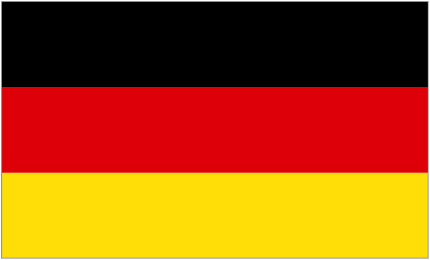 1889 - Publication of her best selling novel, Die Waffen nieder! ("Lay Down Your Arms!") by Edgar Pierson in Dresden (Germany). "Reached within a short time, a superior awareness and dissemination. Three years later an English edition ("Lay Down Your Arms"), followed in 1897 Italian ("Down with le Armi"), 1899 French ("bas les armes!") And in 1905 a Spanish ("Abajo las armas" ). The novel was printed until 1905 in 37 German editions from various publishers and been translated into 16 languages, including Finnish, Danish ("Ned med Vaabnene!"), Norwegian ("Ned med Vaabnene!"), Swedish and Czech. Until the publication of the novel "The Western Front" by Erich Maria Remarque in 1929 was "Lay down your arms!" as the most important work of the anti-war literature. [Google translation]" Published "The Machine Age" in the same year (1889). 1889 - Publication of her best selling novel, Die Waffen nieder! ("Lay Down Your Arms!") by Edgar Pierson in Dresden (Germany). "Reached within a short time, a superior awareness and dissemination. Three years later an English edition ("Lay Down Your Arms"), followed in 1897 Italian ("Down with le Armi"), 1899 French ("bas les armes!") And in 1905 a Spanish ("Abajo las armas" ). The novel was printed until 1905 in 37 German editions from various publishers and been translated into 16 languages, including Finnish, Danish ("Ned med Vaabnene!"), Norwegian ("Ned med Vaabnene!"), Swedish and Czech. Until the publication of the novel "The Western Front" by Erich Maria Remarque in 1929 was "Lay down your arms!" as the most important work of the anti-war literature. [Google translation]" Published "The Machine Age" in the same year (1889).
|
 1891 - Following the publication by Baroness Bertha von Suttner [1843-1914] of Die Waffen nieder! (Lay Down Your Arms) in 1889, he and von Suttner began in Berlin (Germany) to publish a magazine of the same name. First issue appears in January 1892. In articles published within Die Waffen nieder! & its successor, Die Friedenswarte (The Peace Watch), he articulated his pacifist philosophy.
1891 - Following the publication by Baroness Bertha von Suttner [1843-1914] of Die Waffen nieder! (Lay Down Your Arms) in 1889, he and von Suttner began in Berlin (Germany) to publish a magazine of the same name. First issue appears in January 1892. In articles published within Die Waffen nieder! & its successor, Die Friedenswarte (The Peace Watch), he articulated his pacifist philosophy.
 1892 - In 1892 he was a co-founder of the Deutsche Friedensgesellschaft (German Peace Society), which becomes the focus for the German pacifist movement before World War I. He was one of the fathers of the idea of a modern organisation to assure worldwide peace. (The principal idea was fulfilled in the League of Nations & after the Second World War in the UN). Fried advocated "fundamental pacifism" & believed that "international anarchy" should be met by both legislative measures & spiritual regeneration.
1892 - In 1892 he was a co-founder of the Deutsche Friedensgesellschaft (German Peace Society), which becomes the focus for the German pacifist movement before World War I. He was one of the fathers of the idea of a modern organisation to assure worldwide peace. (The principal idea was fulfilled in the League of Nations & after the Second World War in the UN). Fried advocated "fundamental pacifism" & believed that "international anarchy" should be met by both legislative measures & spiritual regeneration.
 1899 - From 1899 Die Waffen nieder! is called Friedenswarte (The Peacekeeper).
1899 - From 1899 Die Waffen nieder! is called Friedenswarte (The Peacekeeper).
 1903 - Fried was a prominent member of the Esperanto-movement. In 1903 he published the book Lehrbuch der internationalen Hilfssprache Esperanto (Textbook of the International Language of Esperanto). Click here for monuments related to Esperanto & to its creator, Ludwik Zamenhof [1959-1917].
1903 - Fried was a prominent member of the Esperanto-movement. In 1903 he published the book Lehrbuch der internationalen Hilfssprache Esperanto (Textbook of the International Language of Esperanto). Click here for monuments related to Esperanto & to its creator, Ludwik Zamenhof [1959-1917]. 
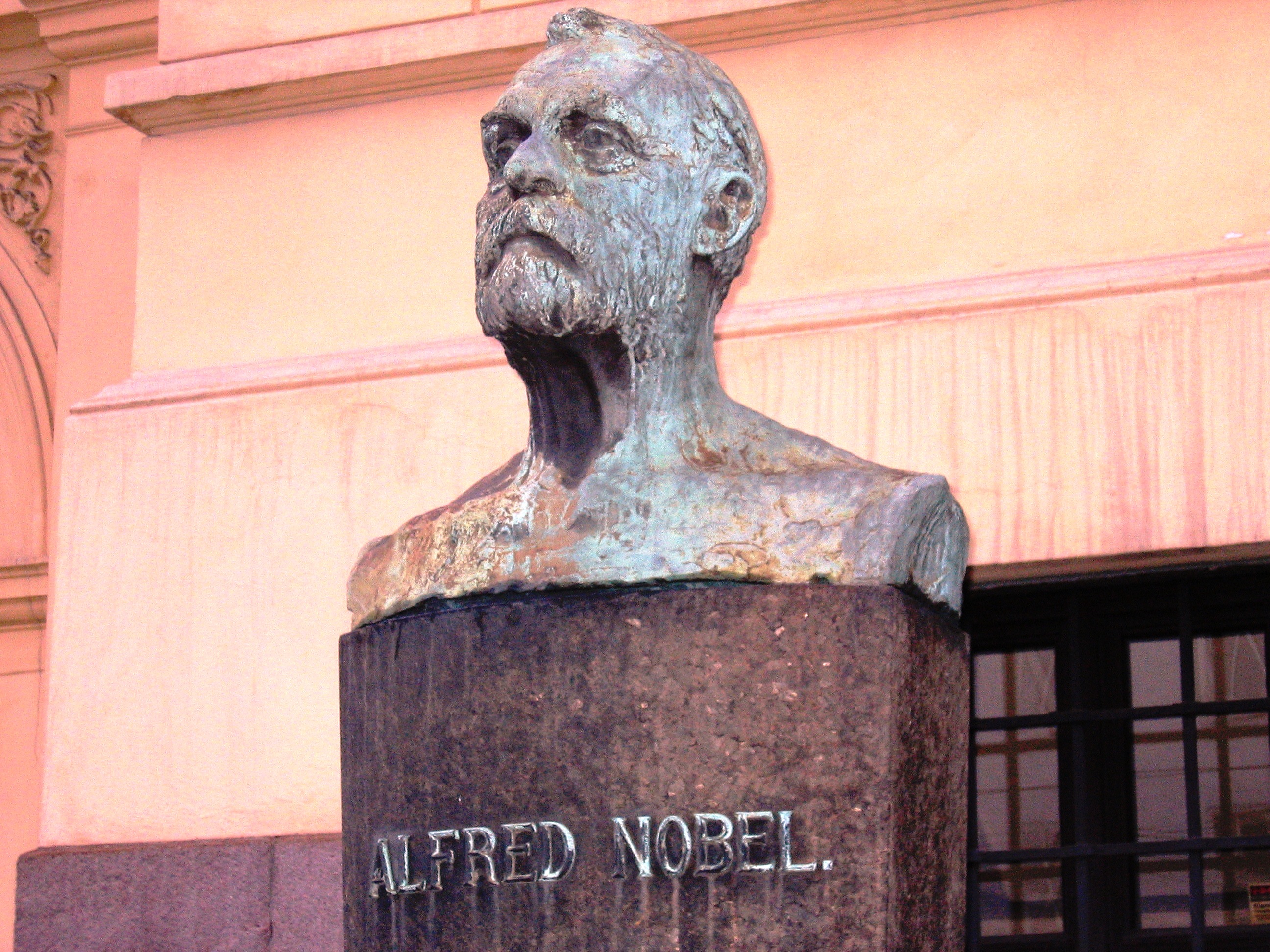 | N
O
B
E
L |
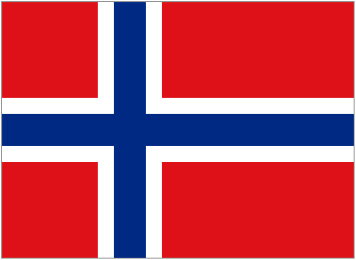 1905 - Oslo (Norway). Baroness Vertha von Suttner obtains the fifth Nobel Peace Prize & becomes the first woman peace laureate. She visits Denmark after receiving the prize. Image is bust of Alfred Nobel in Oslo (Norway). 1905 - Oslo (Norway). Baroness Vertha von Suttner obtains the fifth Nobel Peace Prize & becomes the first woman peace laureate. She visits Denmark after receiving the prize. Image is bust of Alfred Nobel in Oslo (Norway). 
|
 1911 - Fried shared Nobel Peace Prize with Tobias Asser [1838-1913]. 100th anniversary will be in 2011.
1911 - Fried shared Nobel Peace Prize with Tobias Asser [1838-1913]. 100th anniversary will be in 2011. 
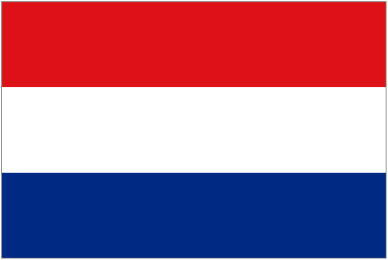 August 28, 1913 - Bertha von Suttner spoke at this dedication in The Hague. Did Fried? Note that it's only 50 days before another important dedication in Leipzig (Germany).
August 28, 1913 - Bertha von Suttner spoke at this dedication in The Hague. Did Fried? Note that it's only 50 days before another important dedication in Leipzig (Germany).
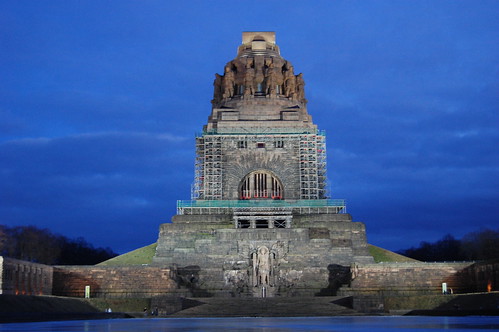

| M
E
M |  October 18, 1913 - Völkerschlachtdenkmal / Monument to the Battle of the Nations, Leipzig (Germany). Commemorates Napoleon's defeat during the Battle of Leipzig October 16-19, 1813. "Considered to be Europe’s largest memorial. Its construction required a total of 120,000 m3 of tamped concrete & 12,500 m3 of porphyroid granite. The imposing 90-metre-high monument is currently being restored. The aim is to have it shining in the same splendour on its 100th anniversary as at its opening in 1913." October 18, 1913 - Völkerschlachtdenkmal / Monument to the Battle of the Nations, Leipzig (Germany). Commemorates Napoleon's defeat during the Battle of Leipzig October 16-19, 1813. "Considered to be Europe’s largest memorial. Its construction required a total of 120,000 m3 of tamped concrete & 12,500 m3 of porphyroid granite. The imposing 90-metre-high monument is currently being restored. The aim is to have it shining in the same splendour on its 100th anniversary as at its opening in 1913."
|
 October 18, 1913 - At the dedication in Leipzig, Fried said: "We have almost too many war and battle commemorations, and the danger exists, that because of only looking backwards, we lose sight of the view before us, and of the greatness of the present... We are fundamentally no friends of commemorating battles. Their purpose is to maintain the war-like mentality and through the memory of the deeds of the fathers to encourge the younger generation to follow suit... Certainly, we should never forget our history... We should remember what our fathers did, and their suffering. But always only in the sense of piety; not in a blind adoration of the past...We can join in the Leipzig days celebrations because they brought about the victory of order through the cooperation of the nations. Germans, Austrians, and among them many non-Germans, Russians and Swedes worked together, and only this international agreement could succeed in what individually they could not, namely overcoming he who threatened the old order... We rejoice in the fact that, in the same year thast th Battle of Nations Memorial was erectred in Leipzig, which points towards the past, in the Hague the Peace Palace was erected as an International Law Memorial which points towards a happy future... In this way we are honouring the heroes of the past and the memory of the dead, who lost their lives in the fight against the armed conqueror, and at the same time are honouring the efforts of those who labour to bring about an era of concord between the nations." /// According to Peter van den Dungen (2003, p. 131), "Völkerschlachtdenkmal was therefore also a warning to any future disturbers of the peace who would contemplate armed aggression across their borders."
October 18, 1913 - At the dedication in Leipzig, Fried said: "We have almost too many war and battle commemorations, and the danger exists, that because of only looking backwards, we lose sight of the view before us, and of the greatness of the present... We are fundamentally no friends of commemorating battles. Their purpose is to maintain the war-like mentality and through the memory of the deeds of the fathers to encourge the younger generation to follow suit... Certainly, we should never forget our history... We should remember what our fathers did, and their suffering. But always only in the sense of piety; not in a blind adoration of the past...We can join in the Leipzig days celebrations because they brought about the victory of order through the cooperation of the nations. Germans, Austrians, and among them many non-Germans, Russians and Swedes worked together, and only this international agreement could succeed in what individually they could not, namely overcoming he who threatened the old order... We rejoice in the fact that, in the same year thast th Battle of Nations Memorial was erectred in Leipzig, which points towards the past, in the Hague the Peace Palace was erected as an International Law Memorial which points towards a happy future... In this way we are honouring the heroes of the past and the memory of the dead, who lost their lives in the fight against the armed conqueror, and at the same time are honouring the efforts of those who labour to bring about an era of concord between the nations." /// According to Peter van den Dungen (2003, p. 131), "Völkerschlachtdenkmal was therefore also a warning to any future disturbers of the peace who would contemplate armed aggression across their borders."
 WW-I - During the First World War Fried lived in Switzerland.
WW-I - During the First World War Fried lived in Switzerland.
 May 5, 1921 - Fried's death in Vienna (Austria). 90th anniversary will be in 2011.
May 5, 1921 - Fried's death in Vienna (Austria). 90th anniversary will be in 2011.

 |
 1989 - Commemorative postage stamp (Austria). 1989 - Commemorative postage stamp (Austria).
|
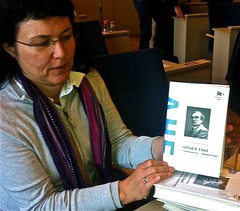 
 | B
O
O
K |
 2010? - "Petra Schoenemann-Behrens, with her recent biography of Alfred H. Fried. I helped Petra find a publisher and wrote an epilogue." [Peter van den Dungen, Nov. 7, 2011] Photo from Andreas Landl, the peace journalist from Vienna. 2010? - "Petra Schoenemann-Behrens, with her recent biography of Alfred H. Fried. I helped Petra find a publisher and wrote an epilogue." [Peter van den Dungen, Nov. 7, 2011] Photo from Andreas Landl, the peace journalist from Vienna.
|

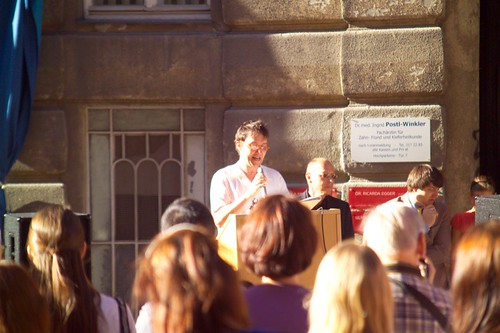
 | P
L
A
Q
U
E |  May 25, 2011 - Memorial plaque for Alfred Hermann Fried, Widerhofergasse 5, 9th district, Vienna (Austria). Fried [1864-1921] was an Austrian Jewish pacifist, publicist, journalist & co-founder of the German peace movement. Shared Nobel prize with Tobias Asser) [1838-1913]. The plaque is "his first Memorial in Vienna... More than 200 people and took part in the ceremony. Klaus Maria Brandauer unveiled the commemorative plaque at the fountain Hevenu Shalom choir sang." Google translation: "... Europe is not the affair of an individual State...
/ ORGANIZE THE WORLD!
/ ALFRED HERMANN FRIED
/ * November 11, 1864 in Vienna. + 4 May 1921 in same place.
/ Lived in this house when he was awarded the Nobel Peace Prize in 1911.
/ He is considered the founder of peace research.
/ This marks the 100th Anniversary of the Nobel Peace Prize ceremony." /// Info & image courtesy of Peter van den Dungen. May 25, 2011 - Memorial plaque for Alfred Hermann Fried, Widerhofergasse 5, 9th district, Vienna (Austria). Fried [1864-1921] was an Austrian Jewish pacifist, publicist, journalist & co-founder of the German peace movement. Shared Nobel prize with Tobias Asser) [1838-1913]. The plaque is "his first Memorial in Vienna... More than 200 people and took part in the ceremony. Klaus Maria Brandauer unveiled the commemorative plaque at the fountain Hevenu Shalom choir sang." Google translation: "... Europe is not the affair of an individual State...
/ ORGANIZE THE WORLD!
/ ALFRED HERMANN FRIED
/ * November 11, 1864 in Vienna. + 4 May 1921 in same place.
/ Lived in this house when he was awarded the Nobel Peace Prize in 1911.
/ He is considered the founder of peace research.
/ This marks the 100th Anniversary of the Nobel Peace Prize ceremony." /// Info & image courtesy of Peter van den Dungen.
|
 |
 October 28-29, 2011 -Symposium zu Friedensaktivist Fried / Sympossium on Peaceactivist Fried, Town Hall, Friedrich-Ebert-Strasse, Potsdam (Germany). "Who knows the German Peace Prize? In Potsdam, Bertha von Suttner is still present, less their long-time employee and later winner Alfred Hermann Fried. The Vienna-born peace activist, founded in 1892 with her ??along the German Peace Society and 'The peace waiting.' The monthly magazine quickly developed into an important organ of the peace movement. 100 years after the [Nobel] award ceremony, organized by the International Peace Bureau (IPB) in cooperation with the Working Group Historical Peace Research (AKHF), Bertha von Suttner Foundation of the German Peace Society & the United War Resisters (DFG-VK) a two-day symposium on 'Organize the world! The Nobel Peace Prize laureate Alfred Hermann Fried (1864-1921): Life, work and lasting impact.' [Google translation]" Click here for final symposium program in German & English (PDF file). October 28-29, 2011 -Symposium zu Friedensaktivist Fried / Sympossium on Peaceactivist Fried, Town Hall, Friedrich-Ebert-Strasse, Potsdam (Germany). "Who knows the German Peace Prize? In Potsdam, Bertha von Suttner is still present, less their long-time employee and later winner Alfred Hermann Fried. The Vienna-born peace activist, founded in 1892 with her ??along the German Peace Society and 'The peace waiting.' The monthly magazine quickly developed into an important organ of the peace movement. 100 years after the [Nobel] award ceremony, organized by the International Peace Bureau (IPB) in cooperation with the Working Group Historical Peace Research (AKHF), Bertha von Suttner Foundation of the German Peace Society & the United War Resisters (DFG-VK) a two-day symposium on 'Organize the world! The Nobel Peace Prize laureate Alfred Hermann Fried (1864-1921): Life, work and lasting impact.' [Google translation]" Click here for final symposium program in German & English (PDF file).
|
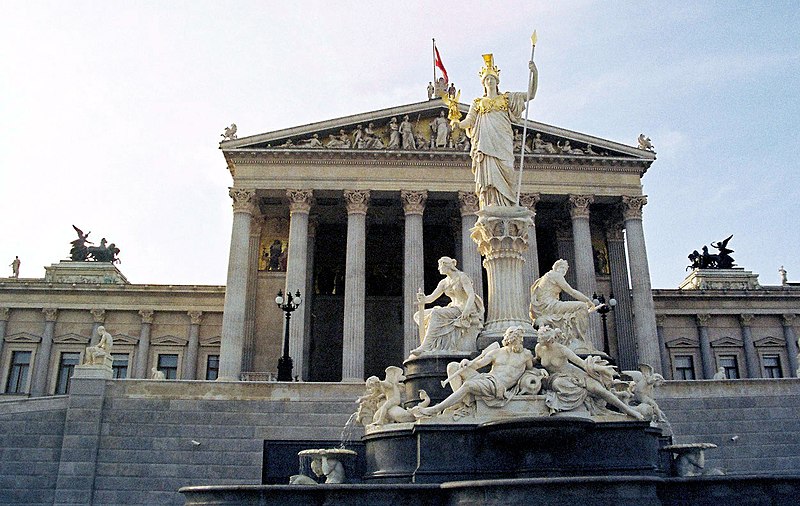
 |
 December 1, 2011 - "A second seminar on Fried is due to be held in the Austrian Parliament, Vienna (Austria), on Dec 1st, 2011." December 1, 2011 - "A second seminar on Fried is due to be held in the Austrian Parliament, Vienna (Austria), on Dec 1st, 2011."
|


November 11, 1864 - Birth in Vienna (Austria-Hungary).



1891 - Following the publication by Baroness Bertha von Suttner [1843-1914] of
1892 - In 1892 he was a co-founder of the Deutsche Friedensgesellschaft (German Peace Society), which becomes the focus for the German pacifist movement before World War I. He was one of the fathers of the idea of a modern organisation to assure worldwide peace. (The principal idea was fulfilled in the League of Nations & after the Second World War in the UN). Fried advocated "fundamental pacifism" & believed that "international anarchy" should be met by both legislative measures & spiritual regeneration.
1899 - From 1899 Die Waffen nieder! is called Friedenswarte (The Peacekeeper).
1903 - Fried was a prominent member of the Esperanto-movement. In 1903 he published the book Lehrbuch der internationalen Hilfssprache Esperanto (Textbook of the International Language of Esperanto). Click here for monuments related to Esperanto & to its creator, Ludwik Zamenhof [1959-1917].
![]()

1905 - Oslo (Norway). Baroness Vertha von Suttner obtains the fifth Nobel Peace Prize & becomes the first woman peace laureate. She visits Denmark after receiving the prize. Image is bust of Alfred Nobel in Oslo (Norway).
![]()
1911 - Fried shared Nobel Peace Prize with Tobias Asser [1838-1913]. 100th anniversary will be in 2011.
![]()

August 28, 1913 - Vredespaleis / Peace Palace, Carnegieplein 2, The Hague (Netherlands). Constructed just before World War I by the Carnegie Foundation -- and still owned by the Carnegie Foundation. (Philanthropist Andrew Carnegie [1835-1919] previously paid for the Pan American Union building -- now the Organization of American States (OAS) -- in Washington, DC (USA) in 1910.) The Peace Palace is now home of the International Court of Justice (ICJ) or World Court, the Permanent Court of Arbitration (PCA), the Peace Palace Library, and the Hague Academy of International Law. 1 of 40 monuments in "Peace Symbols" by Zonia Baber (1948), pp. 26-27.
August 28, 1913 - Bertha von Suttner spoke at this dedication in The Hague. Did Fried? Note that it's only 50 days before another important dedication in Leipzig (Germany).

![]()
October 18, 1913 - Völkerschlachtdenkmal / Monument to the Battle of the Nations, Leipzig (Germany). Commemorates Napoleon's defeat during the Battle of Leipzig October 16-19, 1813. "Considered to be Europe’s largest memorial. Its construction required a total of 120,000 m3 of tamped concrete & 12,500 m3 of porphyroid granite. The imposing 90-metre-high monument is currently being restored. The aim is to have it shining in the same splendour on its 100th anniversary as at its opening in 1913."
October 18, 1913 - At the dedication in Leipzig, Fried said: "We have almost too many war and battle commemorations, and the danger exists, that because of only looking backwards, we lose sight of the view before us, and of the greatness of the present... We are fundamentally no friends of commemorating battles. Their purpose is to maintain the war-like mentality and through the memory of the deeds of the fathers to encourge the younger generation to follow suit... Certainly, we should never forget our history... We should remember what our fathers did, and their suffering. But always only in the sense of piety; not in a blind adoration of the past...We can join in the Leipzig days celebrations because they brought about the victory of order through the cooperation of the nations. Germans, Austrians, and among them many non-Germans, Russians and Swedes worked together, and only this international agreement could succeed in what individually they could not, namely overcoming he who threatened the old order... We rejoice in the fact that, in the same year thast th Battle of Nations Memorial was erectred in Leipzig, which points towards the past, in the Hague the Peace Palace was erected as an International Law Memorial which points towards a happy future... In this way we are honouring the heroes of the past and the memory of the dead, who lost their lives in the fight against the armed conqueror, and at the same time are honouring the efforts of those who labour to bring about an era of concord between the nations." /// According to Peter van den Dungen (2003, p. 131), "Völkerschlachtdenkmal was therefore also a warning to any future disturbers of the peace who would contemplate armed aggression across their borders."
WW-I - During the First World War Fried lived in Switzerland.
May 5, 1921 - Fried's death in Vienna (Austria). 90th anniversary will be in 2011.

![]()
1989 - Commemorative postage stamp (Austria).


![]()
2010? - "Petra Schoenemann-Behrens, with her recent biography of Alfred H. Fried. I helped Petra find a publisher and wrote an epilogue." [Peter van den Dungen, Nov. 7, 2011] Photo from Andreas Landl, the peace journalist from Vienna.


![]()
May 25, 2011 - Memorial plaque for Alfred Hermann Fried, Widerhofergasse 5, 9th district, Vienna (Austria). Fried [1864-1921] was an Austrian Jewish pacifist, publicist, journalist & co-founder of the German peace movement. Shared Nobel prize with Tobias Asser) [1838-1913]. The plaque is "his first Memorial in Vienna... More than 200 people and took part in the ceremony. Klaus Maria Brandauer unveiled the commemorative plaque at the fountain Hevenu Shalom choir sang." Google translation: "... Europe is not the affair of an individual State...
/ ORGANIZE THE WORLD!
/ ALFRED HERMANN FRIED
/ * November 11, 1864 in Vienna. + 4 May 1921 in same place.
/ Lived in this house when he was awarded the Nobel Peace Prize in 1911.
/ He is considered the founder of peace research.
/ This marks the 100th Anniversary of the Nobel Peace Prize ceremony." /// Info & image courtesy of Peter van den Dungen.


![]()
September 2011 -
Alfred H. Fried: Friedensaktivist - Nobelpreisträger / Alfred H. Fried: Peace activist - Nobel laureate" by Petra Schoenemann-Behrens. Biography of Alfred H. Fried [1864-1921]. Edited by Andreas Hermann Landl, the peace journalist from Vienna. Contains epilogue by Peter van den Dungen. Photo of Schoenemann-Behrens by Andreas Landl.

October 28-29, 2011 -Symposium zu Friedensaktivist Fried / Sympossium on Peaceactivist Fried, Town Hall, Friedrich-Ebert-Strasse, Potsdam (Germany). "Who knows the German Peace Prize? In Potsdam, Bertha von Suttner is still present, less their long-time employee and later winner Alfred Hermann Fried. The Vienna-born peace activist, founded in 1892 with her ??along the German Peace Society and 'The peace waiting.' The monthly magazine quickly developed into an important organ of the peace movement. 100 years after the [Nobel] award ceremony, organized by the International Peace Bureau (IPB) in cooperation with the Working Group Historical Peace Research (AKHF), Bertha von Suttner Foundation of the German Peace Society & the United War Resisters (DFG-VK) a two-day symposium on 'Organize the world! The Nobel Peace Prize laureate Alfred Hermann Fried (1864-1921): Life, work and lasting impact.' [Google translation]" Click here for final symposium program in German & English (PDF file).

![]()
December 1, 2011 - "A second seminar on Fried is due to be held in the Austrian Parliament, Vienna (Austria), on Dec 1st, 2011."
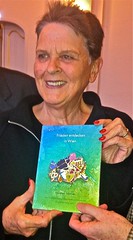
![]()
December 1, 2011 - Wiener Friedenspfade / Vienna peace paths," Vienna (Austria). Suggested by Peter van den Dungen & developed by Suzanne Jalka, the "head" of the Quakers in German-speaking Europe. Image shows Jalka & the trail guide, "Frieden entdecken in Wien / Discovering peace in Vienna," 200 pages (with separate map in pocket inside the back cover), written by Jalka & two co-authors, to be launched December 1 at the Austrian Parliament. "Jalka lives in Cak (Hungary) & works again in her native Vienna (Austria) as a conflict consultant & author." Photo from Andreas Landl, the peace journalist from Vienna.